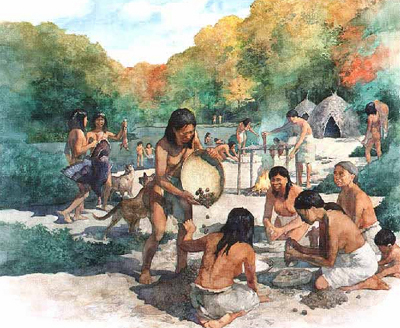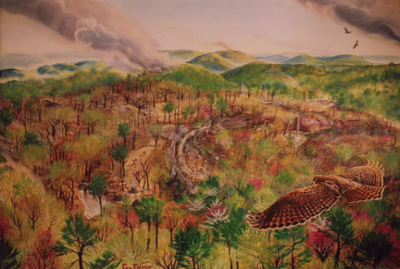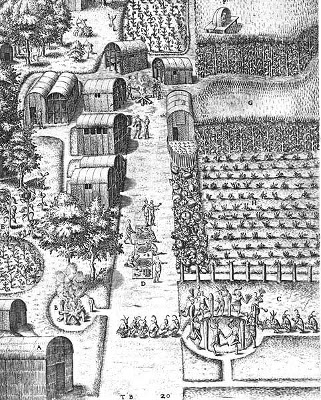
North American native permaculture
 Before
eastern Native Americans domesticated the crops in the Eastern
Agricultural Complex,
they still relied heavily on plants for their
nutrition. Between 8000 BC and 2000 BC (the so-called Archaic
period), Native Americans in our area ate a variety of un-domesticated
native
plants, including the fruits of sumac, blackberry, grape,
hackberry, hawthorn, plum, pawpaw, cherry, mulberry, and persimmon; the
nuts of hickory, oak, hazel,
walnut, chestnut, beech, and pecan; and the sweet insides of honey
locust pods. They also ate the fruits, leaves, or tubers of
Jerusalem artichoke,
two wild beans, groundnut, maypop, black nightshade, amaranth,
pokeweed, carpetweed,
dock, chickweed, ground cherry, purslane, carpetweed, panicgrass, hog
peanut, and a
spurge. Most of these plants continued to be important in the
Native American diet for thousands of years thereafter.
Before
eastern Native Americans domesticated the crops in the Eastern
Agricultural Complex,
they still relied heavily on plants for their
nutrition. Between 8000 BC and 2000 BC (the so-called Archaic
period), Native Americans in our area ate a variety of un-domesticated
native
plants, including the fruits of sumac, blackberry, grape,
hackberry, hawthorn, plum, pawpaw, cherry, mulberry, and persimmon; the
nuts of hickory, oak, hazel,
walnut, chestnut, beech, and pecan; and the sweet insides of honey
locust pods. They also ate the fruits, leaves, or tubers of
Jerusalem artichoke,
two wild beans, groundnut, maypop, black nightshade, amaranth,
pokeweed, carpetweed,
dock, chickweed, ground cherry, purslane, carpetweed, panicgrass, hog
peanut, and a
spurge. Most of these plants continued to be important in the
Native American diet for thousands of years thereafter.
 If you've ever picked up a
book on eastern
North American edible
plants, you'll have
noticed that most of the top edibles are listed above.
So the Native Americans just figured out what was edible and they
wandered around all day looking for them, right? In Cultivated
Landscapes of Native North America,
William E. Doolittle makes a strong case for the hypothesis that most
or all of these "wild"
plants were cultivated to some extent, even though they weren't
domesticated. You'll notice that nearly all of the woody plants
listed aren't old growth species and instead require some space and
extra sunlight to produce plenty of fruits. Native Americans cut
the competition away from favored plants, burned out the undergrowth,
pruned trees and vines to make fruits larger and easier to harvest, and
transplanted edible-fruited trees to the edges of their fields after
they began growing domesticated crops. A great deal of evidence
exists to suggest that grapes were propagated by cuttings and planted
in vineyards, mulberry trees were planted near homes, and chickasaw
plums and pecans were carried east from their natural range to plant
throughout the South.
If you've ever picked up a
book on eastern
North American edible
plants, you'll have
noticed that most of the top edibles are listed above.
So the Native Americans just figured out what was edible and they
wandered around all day looking for them, right? In Cultivated
Landscapes of Native North America,
William E. Doolittle makes a strong case for the hypothesis that most
or all of these "wild"
plants were cultivated to some extent, even though they weren't
domesticated. You'll notice that nearly all of the woody plants
listed aren't old growth species and instead require some space and
extra sunlight to produce plenty of fruits. Native Americans cut
the competition away from favored plants, burned out the undergrowth,
pruned trees and vines to make fruits larger and easier to harvest, and
transplanted edible-fruited trees to the edges of their fields after
they began growing domesticated crops. A great deal of evidence
exists to suggest that grapes were propagated by cuttings and planted
in vineyards, mulberry trees were planted near homes, and chickasaw
plums and pecans were carried east from their natural range to plant
throughout the South.
 Smaller edibles were also encouraged in much
the same way that a modern
gardener might let a volunteer vegetable alone once he recognizes its
worth. A wide range of small plants weren't completely dependent
on the Native Americans for their care (like the Eastern Agricultural
Complex was) but still benefited from a bit of encouragement and were
then eaten. Many of the plants listed in the last sentence of the
first paragraph are
weedy species that require some disturbance in order to grow, so they
sprang up in the Native American's cultivated fields. At the time
of European contact, it was common to see maypops, Jerusalem
artichokes, and other "weeds" allowed to grow in the corn fields, to be
harvested for food.
Smaller edibles were also encouraged in much
the same way that a modern
gardener might let a volunteer vegetable alone once he recognizes its
worth. A wide range of small plants weren't completely dependent
on the Native Americans for their care (like the Eastern Agricultural
Complex was) but still benefited from a bit of encouragement and were
then eaten. Many of the plants listed in the last sentence of the
first paragraph are
weedy species that require some disturbance in order to grow, so they
sprang up in the Native American's cultivated fields. At the time
of European contact, it was common to see maypops, Jerusalem
artichokes, and other "weeds" allowed to grow in the corn fields, to be
harvested for food.
Although the native
North American systems of encouraging wild plants
weren't as intricate as the forest gardens you see in the tropics, the
widespread range and abundance of many of the species mentioned in this
post can probably be
linked back to the continent's earliest human inhabitants. It
begs the question --- are you really wildcrafting when you harvest the
ubiquitous pokeweed growing behind your house, or are you just eating
the remains of a Native American garden?
| This post is part of our Native American Paleoethnobotany lunchtime
series.
Read all of the entries: |
Want more in-depth information? Browse through our books.
Or explore more posts by date or by subject.
About us: Anna Hess and Mark Hamilton spent over a decade living self-sufficiently in the mountains of Virginia before moving north to start over from scratch in the foothills of Ohio. They've experimented with permaculture, no-till gardening, trailersteading, home-based microbusinesses and much more, writing about their adventures in both blogs and books.
Want to be notified when new comments are posted on this page? Click on the RSS button after you add a comment to subscribe to the comment feed, or simply check the box beside "email replies to me" while writing your comment.
